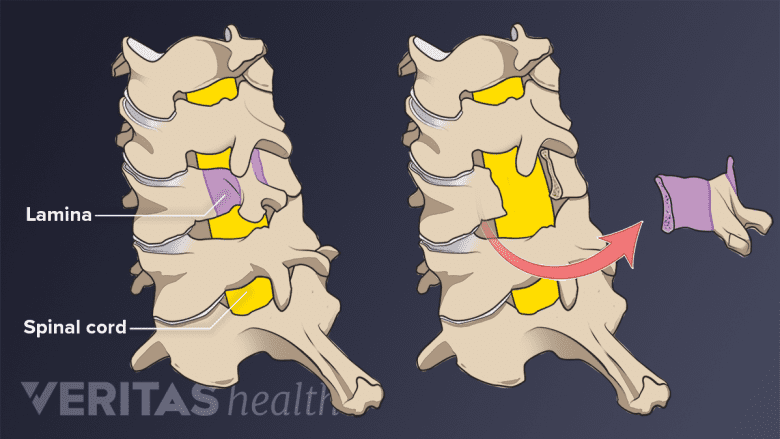When neurological deficits, such as numbness or weakness that goes into the arm or hand, continues to worsen despite nonsurgical treatments, surgery may be considered. The goal of surgery for cervical foraminal stenosis is to decompress the inflamed nerve root in order to give it more space to heal and function better.
Depending on the cause and extent of the cervical foraminal stenosis, multiple surgical options may be considered. When cervical foraminal stenosis is severe or causing problems at multiple spinal levels, more than one surgical technique may need to be performed during the procedure.
In This Article:
- Cervical Foraminal Stenosis
- Cervical Foraminal Stenosis Symptoms
- Cervical Foraminal Stenosis Causes and Diagnosis
- Cervical Foraminal Stenosis Treatment
- Cervical Foraminal Stenosis Surgery
Anterior Cervical Discectomy and Fusion (ACDF)
ACDF surgery is performed through a small incision in the front of the neck. The damaged disc is removed, and a bone graft is inserted to restore normal spacing between the adjacent vertebrae. This newly-created space allows enough room for the nerve roots to travel through the foramina unimpeded. A small metal plate is placed on the front of the vertebrae to hold them together so the bones can fuse together over many months.
For neck and/or arm pain related to a compressed nerve root, ACDF is considered the gold standard surgical treatment since it is the most common and backed by long-term studies.
See Anterior Cervical Discectomy and Fusion Complications
Cervical Artificial Disc Replacement

The cervical disc replacement procedure replaces a damaged disc with an artificial one, preserving mobility.
Similar to ACDF (fusion surgery), a cervical artificial disc replacement involves removing a damaged disc through a small incision in the front of the neck. Once the disc is removed, rather than fusing the adjacent vertebrae, an artificial disc is inserted to maintain motion between the vertebrae.
Cervical artificial disc replacement may be a good option in cases where cervical foraminal stenosis is primarily caused by disc degeneration. When disc degeneration is severe and/or accompanied by deteriorating facet joints, an artificial disc may not be recommended.
Cervical Foraminotomy
This surgery involves entering through a small incision in the back of the neck and removing part of the bone and bone spurs (excessive bone growth) in the intervertebral foramen. Other tissues contributing to foraminal stenosis may also be removed, such as part of the disc (microdiscectomy) and/or thickened ligaments. When the intervertebral foramen is cleaned out, the nerve root is decompressed and has enough space to function again.
Cervical foraminotomy is a common alternative to ACDF when treating cervical foraminal stenosis that does not involve a degenerated disc. Foraminotomy has a significantly lower risk of hoarseness/swallowing problems and is usually the treatment of choice in singers since hoarseness is one of the more common side effects of anterior surgery.
See Outpatient Posterior Cervical Foraminotomy and Discectomy
Cervical Laminectomy

Cervical laminectomy involves removing the cervical lamina to relieve spinal cord or nerve pressure.
This surgery is performed through a small incision in the back of the neck and typically involves the removal of both laminae (2 bony segments of the vertebral arch that are connected by the spinous process). With the laminae removed, the spinal cord and nerve roots have more room to function. In severe cases of cervical foraminal stenosis, one or more enlarged facet joints may be removed along with the laminae.
When the disc and facet joints are intact and not contributing to stenosis, laminectomy may be performed without fusion. Laminectomy can also be performed with fusion when needed to maintain enough spinal stability.
Read more about Posterior Cervical Laminectomy
In cases when both a laminectomy and foraminotomy are performed, the procedure is called laminoforaminotomy.
Cervical Foraminal Stenosis Surgery Risks
Surgery for cervical foraminal stenosis is relatively safe and effective in appropriately-selected candidates. As with any surgery, there is always a small risk of serious complications, such as infection, excessive bleeding, nerve injury, and/or severe allergic reaction. Before deciding to have surgery for cervical foraminal stenosis, it is important to discuss the risks and possible treatment alternatives with the spine surgeon.
Read more about Cervical Spine Surgery

